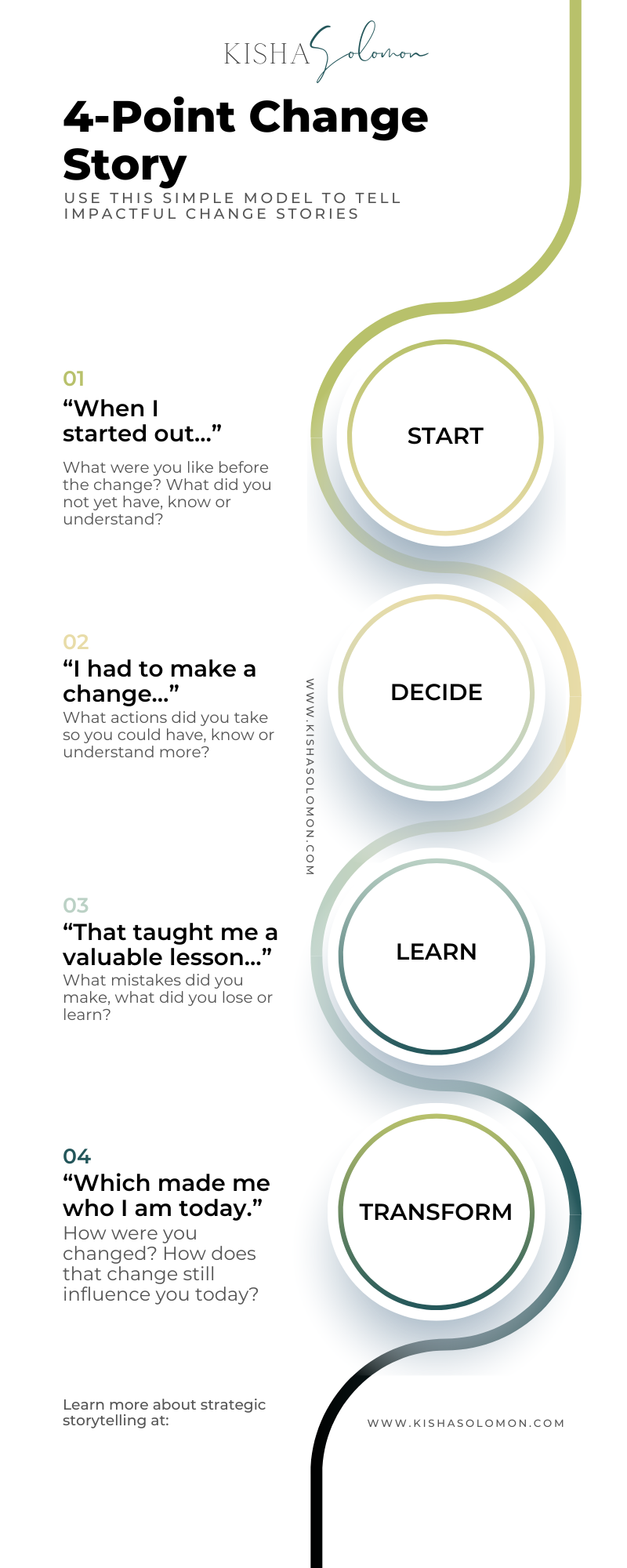The 4-Point Story Model for Telling Compelling Stories
What makes a story compelling? What is it about some stories that make us want to sit up and take notice or even take action?
Often, it’s stories of change or transformation that we find most inspirational or compelling. When we see a main character experience and learn from something it reminds us of our own growth experiences and can even give us a role model for navigating moments of change in our personal stories.
So, if you want to tell a compelling story. Tell a change story.
Story circles are visual structures for change & transformation stories.
www.kishasolomon.com
Story circles are perfectly suited to help structure a change or transformation story. The 2 most popular story circles are Dan Harmon’s story circle and The Hero’s Journey. Each shows how a main character goes through a series of steps to undergo a personal transformation. These story structures are the foundation for many popular books, tv shows and films throughout history.
They are, however, a bit cumbersome and difficult to remember. For that reason, I like to rely on a slimmed-down version of the story circles to help me structure compelling stories. For me, it’s the simplest way to tell a story.
The 4-Point Story Model - The Simplest Way to Tell a Story
Download my free ebook to learn how to use the 4-point story model to tell your signature story.
Download My Free Storytelling Ebook
Don’t know what story to tell or how to tell it? Learn a simple method for telling compelling impact stories. Create a draft of your own signature story. Download Now.
Any change or transformation story can be broken down into the following 4 parts:
Start
Decide
Learn
Transform
Using these 4 parts, you can quickly and consistently structure a story of change about yourself, your team, your customer or your organization.
One universal example I like to use to illustrate the use of the 4-Point Story Model is the movie The Lion King.
In it, the main character goes through a transformation that can be mapped using the 4-Point Story Model.
01 START
At the start – the main character exists in an unchanged state (zone of comfort or lack of awareness).
In the Lion King, this is when Simba is a cub protected by his father Mufasa.
02 DECIDE
Then something happens – It forces the main character to make a decision / to move away from the comfort zone / toward greater awareness.
In the Lion King – this is when Mufasa is killed by Scar and Simba runs away to live a carefree life
03 LEARN
But before they can get there – there’s a price to pay or a lesson to learn. Usually as a result of failure or setback.
Back home, Simba’s family suffers drought & starvation at the hands of the cruel leader Scar. The wise Rafiki reminds Simba of his responsibilities.
04 TRANSFORM
Finally the main character returns – a different & more expanded, mature or aware version of who they were at the start.
With his new friends by his side, Simba returns, defeats Scar. He becomes the new king and a father to his own lion cub.
When to use the 4-Point story MOdel
The 4-Point Story Model has been useful in a number of situations where I needed to relay a story of how someone or something went through a process that resulted in significant or measurable change.
I often use the story model to help me bring more interest to storytelling scenarios where there’s a lot of context to be conveyed, and data alone won’t do. Below are a few examples of when I’ve used the model:
Team retrospectives, lessons learned
Leadership bio / team summary
Project start / update / closeout
Team member intro / exit
Performance assessments, 1:1 sessions
Product (svc) launch / feature release
Strategic decision-making
Customer interviews











